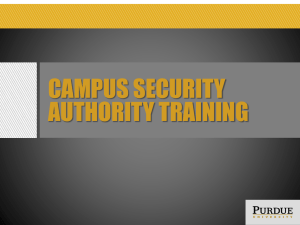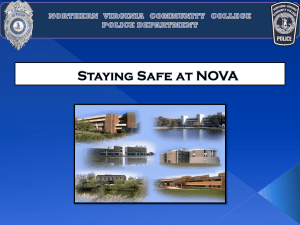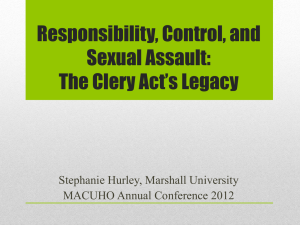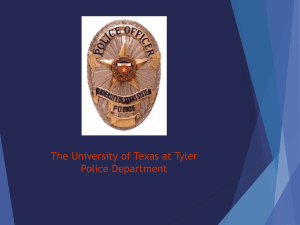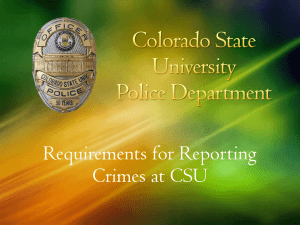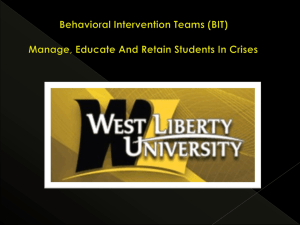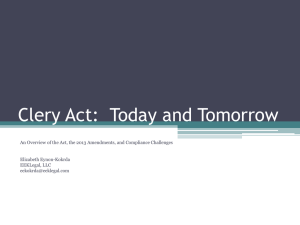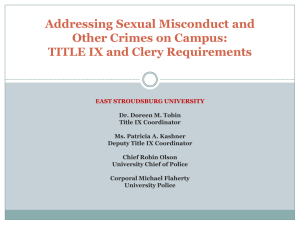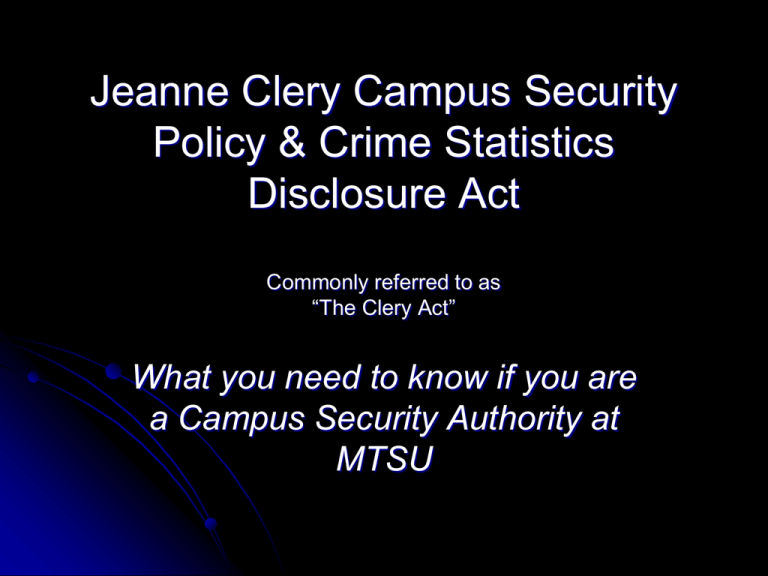
Jeanne Clery Campus Security
Policy & Crime Statistics
Disclosure Act
Commonly referred to as
“The Clery Act”
What you need to know if you are
a Campus Security Authority at
MTSU
What is the Clery Act?
Jeanne Clery was raped and murdered in her dorm room at
Lehigh University in 1986. Her killer was another student.
Her school had not informed students about 38 violent
crimes on campus in the three years preceding her murder.
Her parents believe she would have been more cautious or
made a different school choice if she had known about
other violent crimes at Lehigh. The law enacted in her
memory is intended to ensure that students and other
campus community members are informed about campus
crime so they can make informed decisions.
The Clery Act requires that universities
distribute crime statistics to current
students and all campus employees by
October 1 each year.
Crime statistics must be made available to
all perspective students and staff upon
request.
What’s included in the report?
Crime reporting policy, procedure, and
responses
Access to campus facilities and residence halls
Security considerations used in maintenance
Enforcement and arrest authority of campus
police
Working relationship with state and local police
Encouragement of prompt reporting of crimes
Drug and alcohol abuse prevention information
The report will also include:
Campus and community crime statistics
Policies for reporting crimes and emergencies
Campus Security Authorities and Resources
Campus Sexual Assault Programs
Registered Sex Offender Information
Emergency Notification and Timely Warning
Policy
Missing Student Notification Policy
Annual Fire Safety Report
Crime Log Information
Campuses that maintain a police department are required
to maintain a daily crime log that contains specified
information about any and all crimes that occur within the
patrol jurisdiction of the campus police and that are
reported to the campus police department. The campus
must make the crime log for the most recent 60-day period
open to public inspection during normal business hours,
while crime logs containing material more than 60-days old
must be retained for seven years for public inspection upon
two days’ notice.
But what does this have to do
with YOU?
Many crimes (especially sexual assaults) go unreported
to police but may be reported to others.
Data is collected from Campus Security Authorities to
get the most accurate crime statistics possible – That’s
where you come in.
Timely Warnings
Information provided by CSAs will assist
Public Safety in issuing Timely Warnings to
alert the campus to crimes that pose a
serious or continuing threat.
What makes you a Campus
Security Authority (CSA)?
The law defines four categories of Campus
Security Authority:
University Police
Non-police security staff responsible for monitoring university
property
People or offices designated by our policies as those to whom
crimes should be reported
Officials with significant responsibility for students and campus
activities – THAT’S YOU!
Campus Security Authorities
are:
Defined by function, not title. CSAs have:
Significant responsibility for student and campus
activities;
Regular contact with students
The category of “Campus Security Authority” is defined
broadly to ensure complete coverage and thorough
reporting of crimes.
Examples of
Campus Security Authorities:
- Student housing staff
- Athletic coaches
- Student activities coordinators
- Student judicial officers
- Faculty advisors to student organizations
- Health Services staff
Who ISN’T a
Campus Security Authority
Administrative staff not responsible for students (e.g.,
payroll, facilities)
Clerical Staff
Individual faculty who do NOT serve as advisor to a
registered student organization
Who is EXEMPT from reporting
requirements?
Licensed professional mental health counselors
• Pastoral counselors (employed by a religious
organization to provide confidential counseling) who are
working within the scope of their license or religious
assignment at the time they receive the crime report
So you’re a CSA – What do you
have to do?
If someone tells you about a crime or an incident that may
be a crime, you must record the information and submit a
report to MTSU Public Safety.
Just get the facts, experts will determine the crime
Fill out the CSA reporting form
Tell the victim about options to report and how to do
so
Offer help by connecting to campus programs that
assist victims of sexual assault and other assault.
WHAT do you have to report?
These crimes must be reported:
Homicide
Sex Offenses
Aggravated Assault
Robbery
Burglary
Motor Vehicle Theft
Arson
(Definitions provided separately)
WHAT do you have to report?
(continued)
You must also report:
Hate crimes, including any of the seven previously
listed crimes, and; Larceny-Theft, Simple Assault,
Intimidation, or Destruction/Damage/Vandalism of
Property if motivated by bias (race, gender, religion, sexual
orientation, ethnicity/national origin, disability)
Liquor, drug and weapons violations– both arrests
AND disciplinary referrals
When in doubt report it!
Timing is critical
Be sure to document when the crime or
incident occurred and when it was reported to
you.
The law requires that the crime be reported for
the calendar year in which it was first reported
to a Campus Security Authority, not when it
was reported to police by a CSA.
Location, location, location
A crime must be reported if it
occurred
On campus
In on-campus student residences
On public property adjacent to campus (e.g.,
roads, sidewalks)
On certain off-campus property . . .
Location (continued)
The law includes some off-campus locations
that are a part of, or so closely related to, the
University that crimes occurring at those
locations are included in campus crime
statistics.
Examples: Crimes occurring at student
organization-owned or controlled properties
and at University owned or controlled facilities
“frequently used by students”
How to report crime statistics to
be included in the Clery Report:
For emergencies and crimes in progress, call 9-1-1
MTSU Public Safety (615) 898-2424
Fill out Campus Security Authority Crime & Incident
Report Form found on the MTSU Website:
www.police.mtsu.edu under the CSA Worksheet link
A direct link to the worksheet is:
http://police.mtsu.edu/CSA_Worksheet.pdf
Crimes not connected to
MTSU are not included
For example,
A student tells you about a crime that occurred at a
different college before he transferred to MTSU; or
A student reports an assault that happened while
she was away from campus and not involved in a
campus activity – e.g., at home on spring break, on
vacation, or at a summer job with a private company
Just report the facts
Police will categorize the reported incidents. Your job is
to get the information the person is willing to tell you.
Remember:
You are not a police officer or detective.
You don’t have to prove what happened, determine
who was at fault, or classify the crime.
You aren’t supposed to find the perpetrator.
Use the CSA report form available on the MTSU
Public Safety web page, but DON’T identify the
victim.
Describe Options
Let the person know about options to report
crimes to the police
A person who talks to you may not want to talk to
police – and doesn’t have to.
Exception: when the victim reports a crime to
a professional who is mandated by law to
report specific crimes; for example, child
abuse.
Offer referrals to campus
resources including
MTSU Title IX Coordinator, Carol Clark
MTSU Student Affairs, KUC 212
(615) 898-2440
MTSU Student Health Services
(615) 898-5133
(615) 898-2988
MTSU Counseling Services, KUC 329
(615) 898-2670
Filling out the Report form:
Is a violent crime in progress? If so, call
police immediately!
Describe the incident or crime - What
happened? How, when, and where did it
happen?
Answering questions on the form will help police
determine the correct category
Write a description of the incident
Even incomplete information can help
Filling out the form: you’re not the
expert, and you don’t have to be
You don’t have to know the crime classification
Indicate the crime that seems most likely
Provide as much detail as possible; helps prevent
double reporting of the incident
Public Safety will make the final determination
and classify the crimes
Definitions of Crimes
Aggravated Assault: unlawful attack upon
another with intent to inflict severe or
aggravated bodily injury, using a weapon or
some means likely to produce death or great
bodily harm.
Arson: willful or malicious burning or attempt
to burn a dwelling house, public building,
vehicle, personal property, etc.
Definitions of Crimes
Burglary: unlawful entry of a structure to
commit a felony or a theft.
Criminal Homicide: murder, non-negligent
manslaughter (willful killing of a person); and,
negligent manslaughter (including
vehicular manslaughter) (killing of another
through gross negligence.)
Definitions of Crimes
Disciplinary Referrals: Incidents in which
a student was not arrested, but was
referred for campus disciplinary action for
liquor or drug law violations or illegal
weapons possession.
Drug Law Violation: Violations of state and
local laws related to the possession, sale,
use, growing, manufacturing, and making
of narcotic drugs.
Definitions of Crimes
Hate Crimes: Any of the 7 listed crimes, or
Larceny-Theft, Simple Assault, Intimidation, or
Destruction/Damage/Vandalism of Property
where there is evidence that:
- the crime was motivated by bias; and,
- the victim was intentionally selected
because of the victim’s actual or perceived
race, religion, gender, sexual orientation,
ethnicity/national origin or physical/mental
disability.
Intimidation: Unlawfully placing a person
in reasonable fear of bodily harm through
the use of threatening words and/or other
conduct, but without displaying a weapon
or subjecting the victim to actual physical
attack.
Provided as a Resource to UCLA Campus
Security Authorities
Definitions of Crimes
Larceny/Theft: Unlawful taking, carrying,
leading, or riding away of property from
the possession of another.
Liquor Law Violation: Violation of laws
prohibiting the manufacture, sale,
transporting, furnishing, possessing of
intoxicating liquor or furnishing liquor to a
minor.
Definitions of Crimes
Motor Vehicle Theft: Theft or attempted
theft of a motor vehicle.
Robbery: Taking or attempting to take
anything of value from a person by force
or violence.
Definitions of Crimes
Sex
offenses, forcible and nonforcible
Forcible
sex offenses: rape, sodomy,
forcible fondling, and sexual assault with
an object
Non-forcible: statutory rape and incest
Definitions of Crimes
Simple Assault: Assaults or attempted
assaults where no weapon was used with
no serious injury to the victim.
Vandalism: To willfully destroy, injure,
disfigure, or deface any public or private
property without consent of the owner.
Weapons Law Violation: The violation of
laws or ordinances regulating weapons.
Definitions of Crimes
Questions re: sex offenses:
Was the act committed forced and/or
non-consensual?
Was the victim incapable of giving
consent because of temporary/permanent
mental/physical incapacity, or because
underage?
Was assault facilitated by (including
intoxicated persons) drugs/alcohol?
Definitions of Crimes
Questions re: robbery
Was force or a weapon used or
threatened?
Was victim injured?
Did victim feel fearful, threatened or
endangered?
Definitions of Crimes
Questions regarding burglary:
Was item taken from inside residence
halls, classroom, office, store, lab, or
other structure?
Was structure, room, store, or office
open, closed, or locked?
How did thief get into the structure/
room etc.?
It’s important to establish the elements of burglary
because theft is not reportable under Clery
Definitions of Crimes
Hate crimes questions:
Was the target personal property, a personal
residence, house of worship, or ethnic organization?
Did the incident involve any expression of hatred (e.g.
graffiti, comments) re: race, gender, ethnicity, religion,
sexual orientation, or disability?
Did any personal injury result from the incident?
Report ANY vandalism to property that is the
result of a hate crime
Definitions of Crimes
Liquor, drug, and weapon law violations:
Police report statistics on arrests for liquor, drug, and
weapons-related crimes
Report statistics on disciplinary referrals for drug, liquor, and
weapon law violations (except when the individual was also
arrested for the same act)
Statistics must reflect number of persons involved (head
count), not just number of incidents (for these crimes only)
Annual Clery Report
To get more information on campus safety and
to read the Clery Report go to:
http://police.mtsu.edu/stats/2012MTSUAnnualSecurity
Report.pdf
Questions?
Contact:
Major Jason Morton, Asst. Director Public Safety
Jason.morton@mtsu.edu
615-898-2424
Heidi Zimmerman, University Counsel
Heidi.zimmerman@mtsu.edu
615-898-2025
THANK YOU

